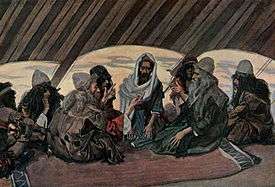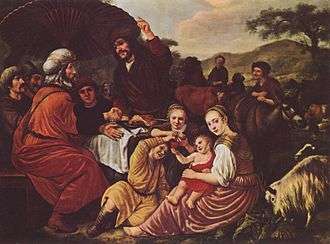Jethro (biblical figure)
In the Hebrew Bible, Jethro (/ˈdʒɛθroʊ/; Hebrew: יִתְרוֹ, Standard Yitro Tiberian Yiṯerô; "His Excellence/Posterity"; Arabic: شعيب Shuʿayb) was Moses' father-in-law, a Kenite shepherd and priest of Midian,[1] but different from Reuel (or Raguel).[2] In Exodus, Moses' father-in-law is initially referred to as "Reuel" (Exodus 2:18) but then as "Jethro" (Exodus 3:1). He was also identified as Hobab in the Book of Numbers 10:29.[3][4]

The relationship of the Biblical Jethro to Islam and the Druze religion is controversial. Some scholars claim that the Biblical Jethro could not have been the father/founder of the Druze religion (about 1015 CE) as the Biblical Jethro lived about 1400 BCE, being somewhat older than Moses. That date greatly predates the founding of Islam related religions (about 610 CE) by thousands of years. Therefore, some scholars claim that Jethro should not be revered as the spiritual founder and chief prophet in his own right of the Druze religion[5][6][7] and is considered an ancestor of all Druze.[8][9]
In Exodus

Jethro is called a priest of Midian and became father-in-law of Moses after he gave his daughter, Zipporah, in marriage to Moses. He is introduced in Exodus 2:18.
Jethro is recorded as living in Midian, a territory stretching along the eastern edge of the Gulf of Aqaba, northwestern Arabia. Some believe Midian is within the Sinai Peninsula. Biblical maps from antiquity show Midian on both locations.
Jethro's daughter, Zipporah (Rohaya), became Moses's wife after Moses had fled Egypt, having killed an Egyptian who was beating a Hebrew slave. Having fled to Midian, Moses intervened in a water-access dispute between Jethro's seven daughters and the local shepherds; Jethro consequently invited Moses into his home and offered him hospitality. However, Moses remained conscious that he was a stranger in exile, naming his first son (Jethro's grandson) "Gershom", meaning "stranger there".
Moses is said to have worked as a shepherd for Jethro for 40 years before returning to Egypt to lead the Hebrews to Canaan, the "promised land". After the Battle at Rephidim against the Amalekites, word reached Jethro that under Moses' leadership the Israelites had been delivered out of Egypt, so he set out to meet with Moses. They met in the wilderness at the "Mountain of God";[10] Moses recounted to Jethro all that had taken place, and then, according to Exodus 18:9–12a:
Jethro rejoiced for all the good which the Lord had done for Israel, whom He had delivered out of the hand of the Egyptians.
And Jethro said, “Blessed be the Lord, who has delivered you out of the hand of the Egyptians and out of the hand of Pharaoh, and who has delivered the people from under the hand of the Egyptians. Now I know that the Lord is greater than all the gods; for in the very thing in which they behaved proudly, He was above them.”
Then Jethro, Moses’ father-in-law, took a burnt offering and other sacrifices to offer to God.[11]
Following this event, it was Jethro who encouraged Moses to appoint others to share in the burden of ministry to the nation Israel by allowing others to help in the judgment of smaller matters coming before him.
These events take place in the Torah portion Yitro (Exodus 18:1–20:23).
Names
There is some disagreement over the name(s) of Moses' father-in-law. In the KJV translation of Judges 4:11, a man named Hobab appears as Moses' father-in-law, while Numbers 10:29 makes him "the son of Raguel [Reuel] the Midianite, Moses' father in law". Reuel is noted Exodus 2:16, as "a priest of Midian" who had seven daughters. Exodus 2:18 "the girls returned to Reuel their father". Reuel becomes Moses' father in law in Exodus 2:21 "Moses agreed to stay with the man, who gave his daughter Zipporah to Moses in marriage."
In Numbers 10:29, the Hebrew for the name Raguel is the same as the Hebrew for Reuel. The reason for the difference is that the Hebrew character ע (ayin) in רעואל is sometimes used merely as a vowel and sometimes as "g", "ng", and "gn", because of the difficulty of its pronunciation by European speakers. Re-u-el, with the first syllable strong accented, is nearer to the true pronunciation. Some suppose he was father to Hobab, who was also called Jethro, a likely possibility.[12]
It became, however, generally accepted that he had seven names: "Reuel", "Jether", "Jethro", "Hobab", "Heber", "Keni" (comp. Judges i. 16, iv. 11), and "Putiel"; Eleazar's father-in-law (Ex. vi. 25) being identified with Jethro by interpreting his name either as "he who abandoned idolatry" or as "who fattened calves for the sake of sacrifices to the idol".[13][14]
Druze
| Part of a series on
Druze |
|---|
 |
|
Beliefs
|
|
Important figures |
|
Texts
|
|
Holy places |
|
Holy days |
|
Related topics
|
|
Jethro, Moses' non-Hebrew father-in-law, is a central figure, particularly in the rites and pilgrimages, of the Druze religion.[15][16] He is viewed as a Prophet in Druze belief.[17][18] Nabi Shuʿayb is the site recognized by Druze as the tomb of Shuʿayb. It is located in Hittin in the Lower Galilee and is the holiest shrine and most important pilgrimage site for the Druze.[19][20] Each year on April 25, the Druze gather at the site in a holiday known as Ziyarat al-Nabi Shuʿayb to discuss community affairs and commemorate the anniversary of Jethro's death with singing, dancing and feasting.[21][22] Another Druze shrine in Ein Qiniyye is the supposed burial place of Jethro's sister, Sit Shahwana.[23]
Jethro is revered as the chief prophet in the Druze religion.[24][7] They believe he was a "hidden" and "true prophet" who communicated directly with God and then passed on that knowledge to Moses, whom they describe as a "recognised" and "revealed prophet."[25][26] According to Druze belief, Moses was allowed to wed Zipporah, the daughter of Jethro, after helping save his daughters and their flock from competing herdsmen. He is also considered an ancestor of the Druze;[8] as is expressed by such prominent Druze as Amal Nasser el-Din,[27] and according to Salman Tarif, who was a prominent Druze shaykh, this makes the Druze related to the Jews through marriage.[28] This view has been used to represent an element of the special relationship between Israeli Jews and Druze.[29] The Israeli Druze also have a folktale called "Jethro's revenge on the [Sunni Muslim] inhabitants of the village of Hittin."[30] In Islam he is mentioned in the Quran as a prophet who was sent to the city of Midian. His people were destroyed because of their corruption except for the believers. He is thought to be the father-in-law for prophet Moses.
See also
- Jethro in rabbinic literature
- Moses in rabbinic literature
- Bithiah
- Jethro in Islam
Notes
- Harris, Stephen L., Understanding the Bible. Palo Alto: Mayfield. 1985.
- Meyers, Carol (1 March 2018). Coogan, Michael D.; Brettler, Marc Z.; Newsom, Carol A.; Perkins, Pheme (eds.). The New Oxford Annotated Bible: New Revised Standard Version (Fifth ed.). Oxford University Press. pp. 81–83. ISBN 978-0-19-027605-8.CS1 maint: ref=harv (link)
- Harris, Stephen (20 January 2010). Understanding The Bible (8 ed.). McGraw-Hill Education. p. 69. ISBN 978-0-07-340744-9.
J names Moses’ father-in-law as Reuel or Hobab, whereas E knows him as Jethro, priest of Midian.
- "Judges 4 / Hebrew – English Bible / Mechon-Mamre".
- Corduan, Winfried (2013). Neighboring Faiths: A Christian Introduction to World Religions. p. 107. ISBN 0-8308-7197-7.
- Mackey, Sandra (2009). Mirror of the Arab World: Lebanon in Conflict. p. 28. ISBN 0-3933-3374-4.
- Lev, David (25 October 2010). "MK Kara: Druze are Descended from Jews". Israel National News. Arutz Sheva. Retrieved 13 April 2011.
- Blumberg, Arnold (1985). Zion Before Zionism: 1838–1880. Syracuse, NY: Syracuse University Press. p. 201. ISBN 0-8156-2336-4.
- Rosenfeld, Judy (1952). Ticket to Israel: An Informative Guide. p. 290.
- Exod 18:5
- Exod: 18:9–12a NKJV
- Clarke, Adam, Commentary on The Holy Bible, Abingdon Press, Nashville, vol. 1, pp. 300–301.
- Ex. R. xxvii. 7; Mek., Yitro, 'Amaleḳ, 1; Tan., Shemot, 11; comp. Targ. pseudo-Jonathan to Ex. vi. 25 and Soṭah 43a
- http://jewishencyclopedia.com/view.jsp?artid=258&letter=J&search=Jethro#1035 JewishEncyclopedia.com – JETHRO
- Robert Ullian (5 November 2010). Frommer's Israel (6 ed.). John Wiley & Sons. p. 422. ISBN 9780470934388.
- Thomas, Amelia (2010). Israel and the Palestinian Territories. p. 45. ISBN 1-7422-0351-5.
- Timothy Hogan (1 March 2012). Entering the Chain of Union. pp. 213–14. ISBN 9781105594236.
According to traditional Druze oral teaching, certain souls in antiquity came to earth (and by some accounts to Egypt in particular) and they all agreed to reincarnate until all humanity had attained Gnosis, or Divine Knowledge of God. The names of these souls were then engraved on two tablets, which were then placed inside two hollow pillars – one to withstand fire and one to withstand water. According to their tradition, Jethro was one of these souls, and he initiated Moses into the tradition. Consequently, Jethro is revered by Druze as one of their greatest Prophets.
- Sol Scharfstein (1 January 1994). Understanding Israel (illustrated ed.). KTAV Publishing House, Inc. p. 22. ISBN 9780881254280.
- Phil Karber (18 June 2012). Fear and Faith in Paradise: Exploring Conflict and Religion in the Middle East. Rowman & Littlefield Publishers. p. 86. ISBN 9781442214798.
- Norbert C. Brockman (13 September 2011). Encyclopedia of Sacred Places [2 volumes] (2, reprint, revised ed.). ABC-CLIO. p. 259. ISBN 9781598846553.
- "Historical Sites". Archived from the original on 10 May 2006.
- Rivka Gonen (2000). Biblical Holy Places: An Illustrated Guide (illustrated, reprint ed.). Paulist Press. p. 212. ISBN 9780809139743.
- Rivka Gonen (2000). Biblical Holy Places: An Illustrated Guide (illustrated, reprint ed.). Paulist Press. p. 85. ISBN 9780809139743.
- Sandra Mackey (16 March 2009). Mirror of the Arab World: Lebanon in Conflict (illustrated, reprint ed.). W. W. Norton & Company. p. 28. ISBN 9780393333749.
- Alex Weingrod (1 January 1985). Studies in Israeli Ethnicity: After the Ingathering. Taylor & Francis. p. 273. ISBN 9782881240072.
The Druze believe that prior to the full revelation of the true religion in the 11th century, there had been a series of "true prophets" whose identities were masked behind that of the "revealed prophet", and through whom they imparted a partial revelation. In accordance with this belief, they claim that Jethro/Shu'eyb was the "true" concealed prophet behind the secondary, revealed prophet, Moses.
- Rivka Gonen (2000). Biblical Holy Places: An Illustrated Guide (illustrated, reprint ed.). Paulist Press. p. 212. ISBN 9780809139743.
The Druze believe that in every generation a prophet appears who is recognized as such by the people but he, in fact, receives his inspiration from a hidden prophet who communicates directly with God. The Druze believe that Jethro was the hidden prophet who inspired Moses, the recognized prophet.
- Mordechai Nisan (1 January 2002). Minorities in the Middle East: A History of Struggle and Self-Expression, 2d ed. McFarland. p. 282. ISBN 9780786451333.
- Eugene L. Rogan; Avi Shlaim (2001). The War for Palestine: Rewriting the History of 1948 (illustrated, reprint ed.). Cambridge University Press. p. 72. ISBN 9780521794763.
- Alex Weingrod (1 January 1985). Studies in Israeli Ethnicity: After the Ingathering. Taylor & Francis. p. 273. ISBN 9782881240072.
- Kais Firro (1999). The Druzes in the Jewish State: A Brief History (illustrated ed.). BRILL. p. 240. ISBN 9789004112513.